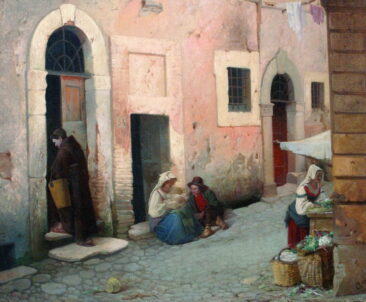

Alexander Antonovich Rizzoni – Russian genre, portrait painter, academician, professor of the Imperial Academy of Arts. One of the greatest masters of academic painting in Russia in the second half of the 19th century: he worked as a genre painter, landscape painter, portrait painter, created the so-called female “heads”. His works are distinguished by a high level of professional skill – the consistency of compositional and coloristic solutions, careful writing of details.
Born into the family of an Ostsee artisan of Italian origin, a native of Bologna – Anton Alexandrovich Rizzoni. Alexander’s elder brother – Pavel Antonovich (1822-1913) – academician of painting at the Imperial Academy of Arts.
A. Rizzoni received his primary education at the Riga district school and the first acquaintance with drawing and painting from his brother Pavel, in 1852 he entered the students of the Imperial Academy of Arts, where he was a student of Professor B.P. Villevald.
During his studies, he twice traveled abroad at his own expense, in 1858 he traveled to Italy and France, in 1860 he visited Spain and Belgium. Received all existing academic awards: in 1857 – a small silver medal for graphic portraits of A.P. Shvabe, O.V. Shvabe, E.K. Frikke and the painting “Musicians in the Tavern (Tavern)”, in 1858 – a large silver medal for the painting “The Italian organ-grinder in the tavern”, in 1860 – a small gold medal for the painting “Smuggling Jews”, in 1862 – a large gold medal for the painting “Auction in the Livonian village”. He was released with the title of class artist of the 1st degree and the right to retirement travel abroad for a period of three years. In 1863-1866 he traveled to France and Italy. Exhibited his work at the Paris Salon (1865-1866).
In 1866 he returned to St. Petersburg, presented to the Council of the Academy of Arts eight miniature paintings depicting the internal views of the synagogue, Roman stables and various commercial establishments; was awarded the title of academician for them and received an extension of the pensioner pay until 1868. In the same year, he held a personal exhibition in Tsarskoe Selo. In late 1866 – early 1867, he traveled across Russia, collecting material for paintings on the themes of folk life. In 1867 he visited the World Exhibition in Paris. He worked in Paris and Rome, visited Spain and Portugal. In 1868, for eleven paintings depicting various scenes from Italian life, he was awarded the title of professor, but did not engage in teaching.
After the expiration of his retirement period, from 1869, he finally settled in Rome, where he lived until his death, periodically coming to Russia. Participated in exhibitions of the Moscow Society of Art Lovers (member of the MOLH since 1867). Exhibited his works at the World Exhibition in Vienna (1873). In 1878 he held a personal exhibition in St. Petersburg. He was friends with P.M. Tretyakov, to whom he helped in the formation of the collection, assisting in the acquisition of works by K.P. Bryullova, S.F. Shchedrin.
He committed suicide in 1902 and was buried in the Monte Testaccio cemetery in Rome.